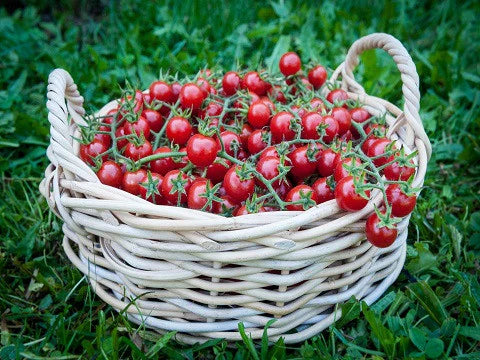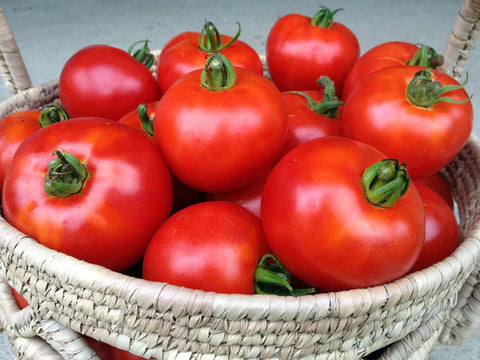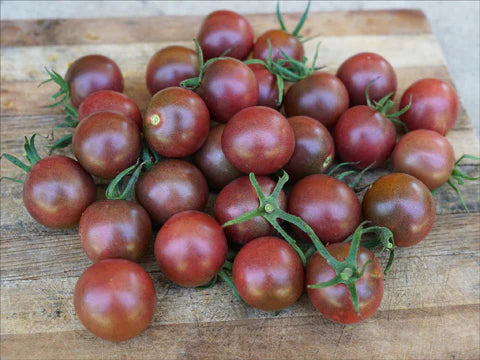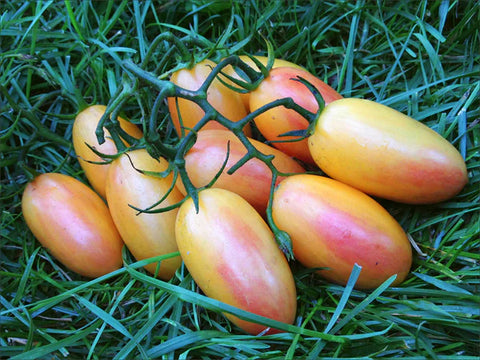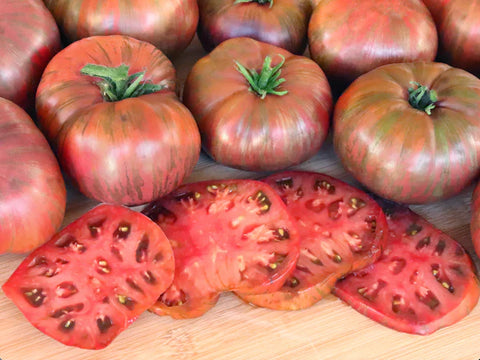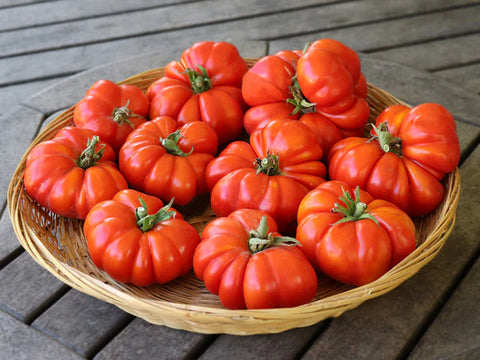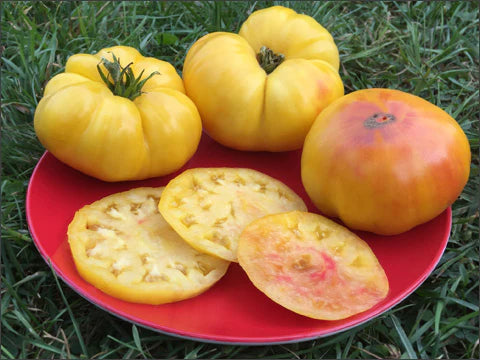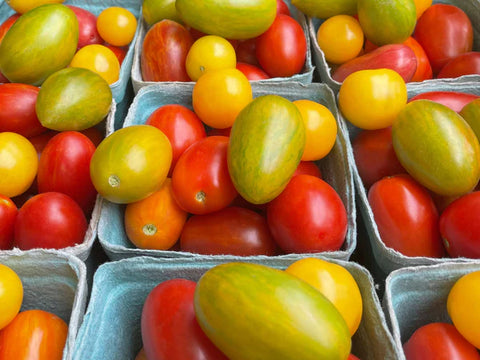Tomatoes are a key ingredient in may of our favorite foods and recipes. They're also delicious and nutritious when eaten raw. there's so much you can do with tomatoes, and it's easy to grow your own! Ready to learn everything you need to know about starting, transplanting, growing, and eating tomatoes? This guide has you covered!
Pictured: Growing-In-Place Cherry Tomato (click for seeds)
🍅 Instructions For Growing Tomatoes 🍅
Tomato seeds are relatively easy to start indoors. In northern climates, tomatoes should be planted indoors so the seedlings are ready to plant outside after the last spring frost. This schedule allows a gardener to get about two months of tomato harvest in the summer before the arrival of the fall frost.
Most importantly, the plants need good-quality soil. Tomato plants are tough and can withstand sub-standard light, such as a sunny window or a cheap fluorescent light fixture; however, they will grow better under 16 hours of light from a quality light fixture (see below).
Once your seedlings are ready to go outside, be sure to follow the instructions for “Hardening Off” to ease the transition to outdoors; otherwise, your plants will be highly stressed. Follow these tips below for the best success.
Pictured: Wisconsin 55 Tomato (click for seeds)
Tomato Seed Starting
Supplies:
- Soil: Vermont Compost’s Fort Vee or Fort Light soil products are recommended. This seed starting kit is also suitable for beginners.
- Heating mat: Tomato seeds will germinate at any temperature between 65° - 90°F, though they will germinate best at 80-86°F. To provide this heat, we recommend using a seed heating mat.
- Container: any container with a drainage hole in the bottom will do
Starting Tomato Seeds:
- In USDA growing Zone 5, start seeds on April 1st
- Sow several seeds per container
- Seed depth: ¼” o Label with variety name and date.
- Keep seeds evenly moist but not overly wet until germination
- Once germinated, remove plants from the heating mat
- Remove all but the one strongest seedling in each container
Pictured: Black Cherry Tomato (click for seeds)
Growing Tomato Seedlings
☀️ Light:
Tomato plants are tough and can be started indoors in sub-standard light, such as a sunny, south-facing window.
Ideally, provide 16 hours of light per day with a light fixture such as T5 fluorescent or High-Pressure Sodium; if you use a light fixture, be sure to follow the instructions regarding the distance between plants and light bulbs because too close will burn plants.
Plug the light fixture into a timer and set it for 16 hours daily. (A timer is available at your local hardware store.)
Provide air circulation with a small oscillating fan set to low-blowing air between your plants and the light.
Plant growing temperature: 65-75°F. If you are using lights, be sure it does not get too hot (> 83°) under the light.
💧 Water:
Water newly planted tomatoes well to ensure soil is moist and ideal for growing. Keep plants moist but not wet.
🌿 Fertilizing:
If you used a compost-based soil mix (such as Vermont Compost’s), you do not need to fertilize your plants. Otherwise, use fish/seaweed liquid fertilizer weekly as directed on the product.
Pictured: Blush Tomato (click for seeds)
Prepare Tomato Plants For Planting (aka “Hardening Off”)
Be sure to harden off your plants before planting them outside. This process takes at least one week and is necessary to acclimate your “wimpy” indoor-grown seedlings to new outdoor conditions (wind, intense sunlight, and temperature fluctuations).To harden off plants:
Start by placing your plants outside in a sunny location for 2 hours, then put them back under the indoor lights. Each day, increase the amount of time (by 1.5 hours) the plants spend in the sun until they spend all day and night outside.
Alternatively, place plants outdoors in a protected (non-windy) location where they will receive only two hours of morning sunlight and be in the shade for the rest of the day. For the first few nights, bring them in at night.
Each day, place your plants in a location that will receive more sunlight and wind so that in 7 days, they will be spending all day and night outside (this can be accomplished by locating them farther and farther away from the source of shade/wind protection).
Pictured: Fred's Tie Dye Dwarf Tomato (click for seeds)
Soil Fertility
Soil fertility is important for tomato yield and quality. Tomatoes can grow in soils that are slightly acidic, with a pH of 5.8 to 6.8. Follow these soil tips:
- Incorporate compost or decomposed manure into soil.
- Consider using a general-purpose organic fertilizer if you think your soil fertility is low.
Pictured: Pisanello Tomato (click for seeds)
🍅 Planting Tomatoes
- Choose a location in full sun where the soil has been amended with organic compost/fertilizer.
- Plant spacing should be 1.5 – 2 feet apart.
- Plant deep so that tomato stems are buried (with some stem and leaf sticking out)
- Label plants with a variety names (if desired)
- Water immediately after planting.
- Water the root area of each plant several times.
- Record in garden journal if desired (date, variety(s), number of plants planted, location).
- Labels in the garden always seem to disappear, so we recommend making a map of your varieties so you know which is which!
💧 Watering Tomatoes
- Tomato plants should be watered 2-3 times weekly, including rain.
- It’s best to water them with soaker hoses or drip irrigation (to avoid getting foliage wet, which helps to minimize fungal diseases like blights).
- Be sure to water frequently during a drought.
- Frequent watering helps to keep tomato fruits from splitting when a big rain comes.
🐛 Common Tomato Pests & Diseases
- Early Blight – Early blight causes spots on lower leaves. The leaves turn yellow and eventually fall from the plant. To prevent early blight, mulch, crop rotation, and remove tomato plants in the fall. It also helps to remove leaves as they become sick.
- Tomato Hornworms – Hand remove caterpillars (if you can find them!) or spray with BT spray.
Tomato Staking Options
Staking tomato plants can help the branches grow in the desired direction and support the weight of ripe fruit. Here are some tips for staking tomatoes.
- Tomato cages: They tend to be weak and fall over and are, therefore, not the best option. However, they are relatively easy to find in garden stores.
- Tall stakes: Place 2x2 stakes so you have 1-3 stakes per plant. Then, tie tomato plants to stakes.
- “Basket-weaving”: If growing more than 5-10 plants, consider the “basket-weaving” method. For more information, check out this video.
To Prune or Not to Prune?
There are many benefits to pruning tomatoes. Reducing foliage and increasing airflow reduces fungal diseases, including Early and Late Blight. However, pruning is time-consuming, so do it if you have time. Check out this video for more detailed instructions on pruning tomatoes.
Pictured: Green Tiger Tomato (click for seeds)
🍝 Tomato Recipes
There are many ways to enjoy your bounty of tomatoes at the end of the season! View these tomato recipes to find some of our favorite ways to eat these fruits of our labor. These include Mike’s Roasted Tomatoes, Erica’s Summer Salad, Erica’s Tomato Sauce, and our personal favorite, Fresh off the Vine!
If you’ve followed these guidelines, you will likely enjoy tons of tomatoes this year!

